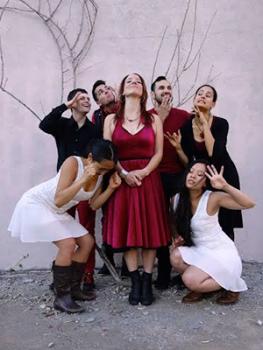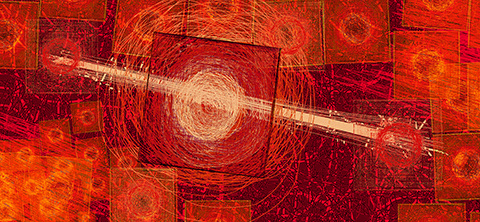Exhibition at Arcadia University Showcases Artists with Neurological Disorders, Through Feb. 8, 2015

Arcadia University’s ARC Exhibition Program is pleased to present Band of Artists: Spectrum Order Disorder in the Commons Art Gallery and the Great Room lobby through Feb. 8, 2015.
This exhibition brings together the work of dancers, performers, photographers, documentary filmmakers, scientists, and educators, as well as professional, student, and untrained artists whose creative paths converge at the crossroads of art making and neurological variation. At the heart of this show are the various creative communities Alan Powell, associate professor of communication and media, has developed throughout a career as an artist and educator spanning four decades.
Powell’s most recent collaborative activities center on his involvement with Band of Artists, a Philadelphia-based performance collective. Founded in 2011 by Powell and Arcadia University alumna Sutie Madison ’11, Band of Artists began as the realization of a simple yet powerful connection between the motor tics that Madison generates as a result of Tourette’s syndrome—eye blinking, eye rolling, facial stretching, head jerking, neck twisting, arm flailing, trunk bending, and stomach convulsions—and the kinetic language of dance. The group of artists, dancers, scientists, and educators use the performance, music, and lecturing as a means for altering public perception of neurological disorders.
Intersection: Tourette Syndrome (2011) and Tourette‘s: A Dancing Disorder (2012) are performances made up of segments including dance, educational presentations, and Q & A panels with the participants. Dance segments are performed with a troupe of 6 to 7 dancers and are backed by live musicians. The choreography is grounded in Madison’s tics, which are combined with movements borrowed from ballet, avant-garde performance, and hip-hop. This hybridization transforms actions that normally carry a social stigma into a demonstration of “creative intelligence,” or as Powell describes it “[Madison] takes movements which are anti-aesthetic and transforms them into a new aesthetic.”
Madison states: “My tics, my physical movements feel almost like antennae. I sort of use them to measure space around me. There’s a certain intelligence in this behavior that the general public is still learning how to read, and I find the chance to raise awareness about it really compelling and powerful.” These works have been performed at venues such as The Painted Bride Art Center in Philadelphia and The James A. Michener Art Museum in Doylestown.
The exhibition includes video documentation of Intersection, which features dancers being forced to interrupt their performance in order to repeatedly wash their hands at the front of the stage, a disruption that evokes the neurological relationship between Tourette’s and obsessive compulsive disorder (OCD). The Unveiling (2012) focuses on the development of motor tics as a physical means of communication.
Also on display are video works that catalog Madison’s earliest attempts at developing her tics into a personal visual language. These include Future’s Going, Madison Code, and Twitch Trials no. 2 and 3 (2011). Also included is documentation of Madison’s performance with the Everett Company in Providence, R.I. in 2011, whose collaborative approach, eclectic influences, and narrative structure would greatly influence Band of Artists.
In addition to the performers and musicians, the Band of Artists community includes a number of additional collaborators. The photographer Gary Funk, who, like Madison, also suffers from Tourette’s, documents the dance troupe as they practice. These images join documentation of Madison’s tics along with a selection of his own landscape photography.
Other examples of photography on display include a series of close-up views of flowers and insects taken by Powell’s colleague Jeff Shultz, a professor in Arcadia’s School of Education. Though Parkinson’s disease has slowed Shultz’s movements, his more deliberate pace has translated into a more acute focus on his surroundings. Though not a trained artist, Shultz uses a camera to record these observations. A documentary by Arcadia graduate Spencer Lalk ’13 detailing Shultz’s disorder is displayed along with his photographs.
“I have the good fortune to be the conscious witness of my own gradual destruction,” is the darkly upbeat way in which the Philadelphia-area artist, writer, and recently retired chief curator of the Michener Art Museum Brian Peterson refers to his Parkinson’s diagnosis in his 2011 memoir The Blossoming of the World: Essays and Images. In this exhibition Peterson is presenting photographs from his series I Sing the Body that digitally layer images of natural foliage and self-portraiture that speak of his own body’s transformation and inevitable deterioration.
The earliest piece in the exhibition is a restored video of the performance Cough Up (1975) by the late artist and curator Willoughby Sharp (1936 – 2008). Powell and the video art collective Electron Movers were commissioned to produce Sharp’s video installations and performances. In Cough Up, Sharp, wearing a gas mask and confined in a small wooden enclosure, confronts the audience about who is in control of the space, and then proceeds, by accident, to set fire to the gallery.
The inclusion of Sharp’s performance in this exhibition, as well as the work of Connie Coleman (1947 – 2011), Powell’s late wife and long-time collaborator, illustrates an important evolution in attitudes toward neurological disorders, both in the broader world and within the context of the art world. According to Powell: “These are professional artists who came from a generation that did not benefit from the kind of hard-core diagnosis that patients receive today. Both displayed addictive and obsessive traits and made attempts to control these symptoms through therapy and medication, prescribed as well as self-administered. However, since they displayed these tendencies under the umbrella of art-making, their symptoms were chalked up to eccentricity or were simply dismissed as part of the creative process.”
 Matthew Clifford, Dizzy Spell, 2006, digital drawing output as inkjet print on double weight matte paper.
Matthew Clifford, Dizzy Spell, 2006, digital drawing output as inkjet print on double weight matte paper.Coleman’s obsessive proclivities are represented by the drawing Sweet Talking Guy (1991). The triptych depicting Dan Rather in front of dancers from the television program Soul Train mimics the activity of a dot matrix printer. These drawings serve as a counterpoint to the digital drawings of Matthew Clifford, a Band of Artists collaborator who uses, rather than imitates, a computer as a tool to record thousands of repeated gestures that build up into abstract compositions of squares and circles.
Both Clifford and Band of Artists performer Jessica Kroboth have collaborated with Powell and the Band of Artist performers on videos that illustrate their personal narratives. Boarding School Twitch (2014) shows performers reacting to a story from Clifford’s childhood in which his undiagnosed motor tics incite a classroom confrontation with a substitute teacher. Kroboth’s Just a Little (2014) combines digital animation, performance documentation, and her narration to depict the inner monologue of an alcoholic attempting to justify taking a drink.
Also included are five colored pencil drawings by the late Stamford, N.Y. resident James Mould (1955 – 2013), a self-taught artist whom Powell encountered through Mould’s instructor Nat Thomas of the Catskill Mountain Artisans Guild. Mould’s Autism manifested, in part, through the repeated rendering of a kind of “tree of life,” a form more evocative of an organic nervous system than a traditional landscape motif.
The show also features several documentaries on subjects with neurological disorders. Eran Preis, professor and director of the graduate program at Temple University’s Department of Film and Media Arts, presents Jonathan’s Return (2012), which examines the experience of a man diagnosed with schizophrenia as a young adult as he migrates between various institutional and national contexts: growing up as a teenager in the United States; serving in the Israeli Army; and returning to the U.S. to secure treatment.
Additional documentaries by Powell’s communication students Joey Abrams ’17, Renee Platz ’13, Chris Sarachilli ’14, and Katie Waters ’14 detail struggles with addiction, paranoid schizophrenia, OCD, and general anxiety disorder. Another of Powell’s students, Brad Christenson, is represented by Hope: A Documentary About Alzheimer’s and Art as Therapy (2012), which tells the story of Dr. G. and how he reinvented himself from neuroradiologist to artist after his diagnosis with Alzheimer’s. Several of Garfinkle’s collages are displayed in the gallery. Other students contributing video pieces to the exhibition include Lee Clawson, Kyle Dixon’16, and Allee Garry ’14.
The exhibition is co-curated by Powell and Matthew Borgen, exhibition coordinator, ARC exhibition program at Arcadia.
More information about Band of Artists can be found at bandofartists.org.
This exhibition was made possible by a donation to the Gateway Society by Theresa and John Rollins. For more information about the exhibition, contact the ARC Exhibition Program (215-572-2629).
Gallery Hours
- Monday – Friday: 7 to 1 a.m.
- Saturday and Sunday: 10 to 1 a.m.

